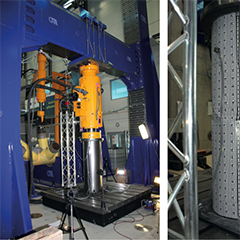Support structures of wind turbines have already been in serial production for a long time. There are now some 1,350 turbines installed in the German North Sea and Baltic Sea alone. The large dimensions, the high dynamic loads, and the specific environmental conditions offshore pose particular challenges and establish the limits of what design codes cover. Despite this, support structures have only suffered minimal serious damage to date, which means that there may still be untapped potential for making these structures even more streamlined. Cost pressures demand that these reserves be quantified more precisely and that potential be identified.
Large-scale tests in particular allow the construction and design to be rendered more customized and thus more efficient. Since 2014, large-scale components and parts have been analyzed and tested and, in turn, design bases and approaches validated in the Test Center Support Structures in Hanover. This article summarizes the key findings from recent project work.
1 Developments and trends
1.1 Supporting structures: versions and their potential
An end to the growth in the size of wind turbines is not yet in sight. Indeed, leading turbine manufacturers are poised to start producing models in the 10 MW plus class. Increasing hub heights, rotor diameters, and capacities also equate to ever greater masses and changed dynamic structural boundary conditions for support structures. Image 1 shows the support structure versions which are currently installed in European offshore wind farms. With a share of around 81%, the majority of turbines continue to be built on monopile foundations. The application limits of this approach have been continuously expanded. Due to their low level of complexity, these structures are quick and simple to manufacture.




























